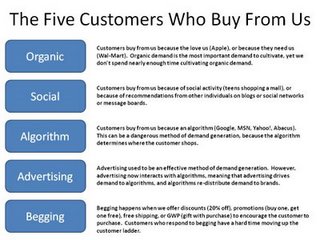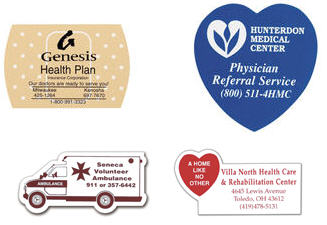Database marketing consultant Kevin Hillstrom has done impressive work in helping retailers trace their customers across sales channels, using Multichannel Forensics (Note: this link is to a PDF file). Now he’s helping clients — and blog readers like me — to find creative ways to re-segment customer files based on responsiveness in a Web 2.0 world.
In his post, Kevin lists five segments of customers. Three are familiar: Organic (those customers who are your without a traceable stimulus, such as advertising), Advertising (they’ve purchased because of a non-discount-related ad) and Begging (you’ve given them discounts and other strong incentives).
Two are new to the Web 2.0 world, and thinking about them is a valuable exercise. They are Algorithmic and Social customers. Here is his description:
Then we have customers who use algorithms to purchase. Yup, these are the customers who use tools like paid search to purchase merchandise. These customers are different. They don’t always respond to future advertising, and when they do respond, they combine advertising and algorithms to make decisions. This is where your Net Google Score comes into play. Catalog brands really struggle with algorithm customers, and online marketers struggle with e-mail marketing programs for algorithm customers.
Increasingly, we find ourselves managing social customers. If you’re Crutchfield, you have customers who buy merchandise, customers who write reviews, and customers who are referred from blogs to your site. The latter two groups represent “social customers”. Social customers are different than are typical catalog customers, and are different than typical e-commerce customers.
These two segments describe a type of purchasing behavior that is brand new. Especially the Social customers.
Hillstrom goes on to say this about Social customers:
Catalogers are way behind the curve when it comes to managing social customers. In fact, almost everybody is behind the curve regarding social customers. Hint: Social customers don’t necessarily embrace catalogs, and sometimes get really angry when [you fill their] mailbox.
Smart catalog marketers are hyper-sensitive to the nature of their customer conversations. Even if you’re not in the catalog retail business, you should be too.
Here are two examples:
- When people arrive at your site from an organic search, greet them with the phrase they searched for (when it is a relevant phrase) and offer several links that can help them better find what they’re seeking. Then trace them to a conversion and compare to a control that receives no greeting.
- When people arrive from a social site, watch where they go within your site. For statistically significant instances (lots of page views, subscriptions to e-newsletters, etc.), consider making a friendly, overt presence on that social network (remember these 11 magic words when posting any social media comments).
Other ideas will come to you when you realize the obvious: The source of a customer changes that customer’s future buying behavior.

